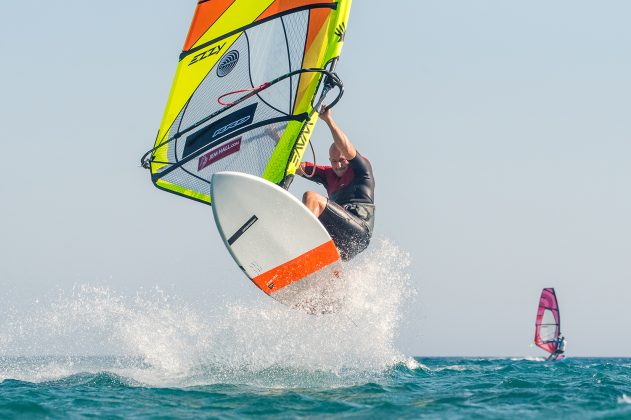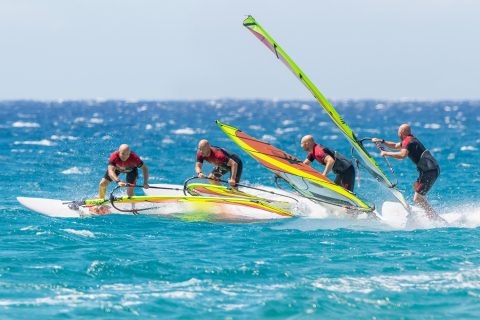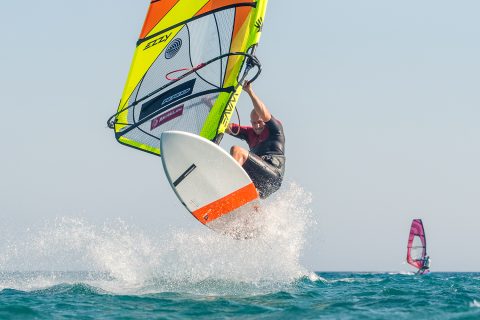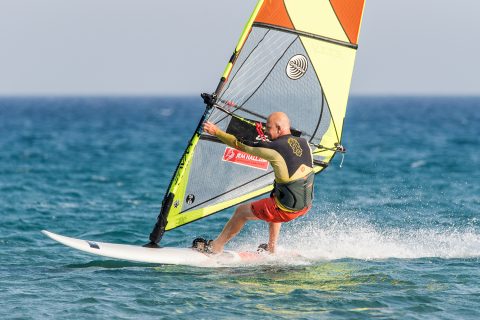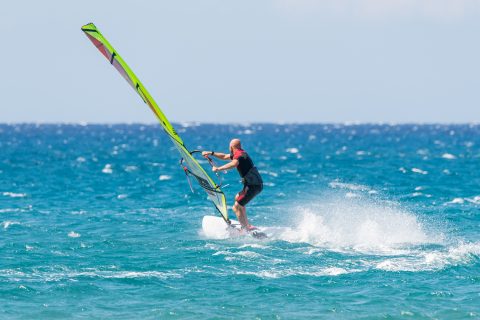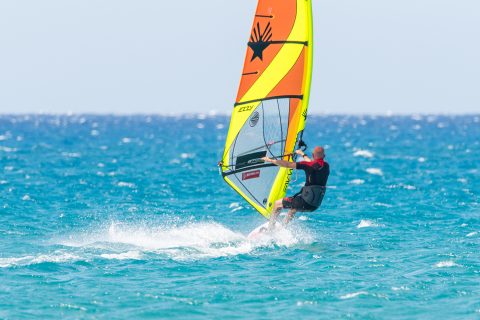JEM HALL
MOVE ON UP – WINDSURFING TECHNIQUE
THE OTHER SIDE
From our October 2021 issue of Windsurf Magazine, our technique guru Jem Hall explains how to do core moves ‘both ways’.
PHOTOS – Eye Sea You Photo
We all have a favoured side for our moves, yet on my clinics I challenge people to learn/improve both ways. The look on their faces when I suggest to do a gybe, tack, jump, loop etc. on their non-favoured ‘other’ side ranges from shock and horror to quiet reflection, before a steely resolve begins to appear. Examples of ‘the other side’ include jumping or chop hopping coming in, or duck gybes going out.
I will be covering the reasons why we may not work on our moves going the other way, and why we should! I will also provide some simple tips as to how we can ease the process across a range of moves.
- Get speed, roll into the carve, increase the carving pressure and then look up the sail as you shift the rig down and back, for your carving 360s going out.
BAD HABITS
- The main reason for not performing on ‘the other side’ is psychological. We may have a negative self-dialogue where we tell ourselves it is not possible, either because of our ability or our ‘biased’ assessment of the conditions on offer. In essence it is you limiting you.
- Next it is the actual conditions. We may choose not to head to spots that need our skills going the other way.
- Failure to set targets. Strategy is more important than technique and we may not ‘make a plan’ to jump coming in, for example.
- As for many moves, the preparation is the most important part of learning/developing a new move. An example of lack of set up is not sailing fast enough and for too short a distance before trying a carving move, like a gybe, 360 or a duck gybe.
- We may choose to try a chop hop coming in too close to the beach, or a carve gybe going out too far away from the beach, where the water is choppier.
- We might be on a board not big enough, or stable enough, to effectively work on tacks on the way out, for example.
- To boost better chop hops, go back to the fundamentals of getting over the board before you pop and then send the nose up in the air by pushing down on the back leg and pulling up on the front arm. Once in flight remember to bring your front arm in, extend your front leg to get the nose off the wind (both more than I am here), and lastly bring your back heel into your bum.
BENEFITS
There are a myriad of benefits to doing our moves both ways in our 2-sided sport. One example that particularly springs to mind for me personally is when I learned to forward loop on flat water. I had the most success on my ‘stronger’ side, yet I also worked on it coming in (my ‘opportunity to improve’ side). Going the other way was not pretty, but it really made me realise what actions were important and as I made my progress it boosted my confidence going ‘both ways’. Other benefits include:
- The ability to do many moves both ways opens up new venues to us, and means we can sail, and perform, across a wider range of conditions and wind directions too.
- Performing a move on our less strong side will help us be more fluid on our stronger side and so both ‘sides’ will grow. It will also help us to identify what really works for us personally to make a breakthrough in our windsurfing development.
- If we know we can tack and gybe well both ways then we have more choices of what transition to use where and when. Furthermore it means we can work on a move when conditions are more favourable going the other way, should the wind change direction for example.
- If we try more moves, in both directions, then we become better at learning and in turn become more flexible in our approach. Lastly it means we embrace the crashing part of our sport more and so we start to enjoy the process as much as the end product.
- To nail tacks on the other side, focus on the basics of getting your preparation completed early and effectively, and across the wind. A reminder of the HUF principle for preparation is – Hand forward first, then Unhook, then come out of the Footstraps.
STRATEGY
- Positive self-dialogue is crucial. Murmuring, ‘I can (shall, will) …. on …. tack,’ really helps.
- Watch videos of the move you want to do and spend time imagining yourself doing it in the direction you have targeted to make progress in. You can also walk through the move, doing the footwork for a tack on a board on land for example.
- Try to not think about which way you are sailing. In Norway I have a few onshore spots and I genuinely forget which way I am heading and just look for opportunities to do moves that I have targeted.
- Doing a move going out, does not mean you have to go all the way out. You can choose to get planing early on the inside and try a duck gybe heading out before it gets too choppy or windy.
- Set the target and do it. A great action one of my clients started doing was writing down on the top of their hands what moves to work on, or key actions to perform, as a checklist when out on the water.
- Mix it up. A great example of this is my circles drill, where you might do 10 rotations of tack on the outside and then gybe on the inside. Then you ‘flip it’ and do the drills the other way round. This is very effective for both planing and non-planing moves.
- Much of the above requires focus, so you hopefully now see how much effort this is! Technically, the most important part of the move to focus on is, as ever, the preparation phase, as this is the first hurdle to pass. As an example, this might be ‘back hand back and get over the board’ to spin loop coming into the beach.
- Believe! A lot of the aforementioned actions we take will help us believe in ourselves more and in our ability to nail this move in our chosen direction. Yet I must emphasise that you have got to really believe, and commit, if you want to make progress.
- Understand this is a journey we are on, one of incremental improvements in performance, so embrace and applaud the successes that we make along the way.
- Be Patient. This new and hopefully successful strategy will take time to set in. So again look to enjoy the journey and remind yourself of the boxes that you have ticked along the way.
- Roll into your carves with flexed ankles and a light rig.
TIPS
- Don’t go into them from sailing fully upwind, instead go back across the wind and get a bit of speed up and ensure you keep low in the preparation phase.
- Get home later. We need speed for these moves and people often do not go downwind enough to get planing early when coming in, and in an attempt to ‘get home’, they head too high upwind. Just go for it and get speed up and get home when you need to, i.e. after your session.
- Carving moves. Do the preparation and ensure you have enough speed to initiate the carve. Ask yourself, “Is my sail light? Has my board speed increased? Am I committed to this?”
- Get a roll with it. As you go into a carving move, ensure you roll across the rail and begin the carve on your front foot with soft flexed ankles. This makes it so much easier in bumpy water.
- Keep the arc. Maintain the right width for the gybe on the outside as people often rush it and turn too tight, or forget to carve and tighten the arc.
- Be choosy. For jumps and pops coming in, there can often be less bumps / chop, or less suitable ones, so choose the better ones and just work on the coordination of the preparation and then the pop. By going for air moves when coming in, your ramp selection skills will also improve!
- Give yourself a breather. For harder moves, that have plenty of crashing, like vulcans and forward loops, it can helpful to stop on the beach, or jump in the water on the outside, to just breathe and give your brain and body a rest and a chance to reset, as you focus on the next attempt.
- Unhook, keep low and get enough speed for your outside carves
Ezzy sails, RRD (boards, wetsuits & softwear), Chinook & Black Project fins sponsor Jem Hall. Get him live and direct on one of his highly acclaimed coaching holidays – check out his website www.jemhall.com for details. You can also follow him on twitter / Facebook / Instagram.


